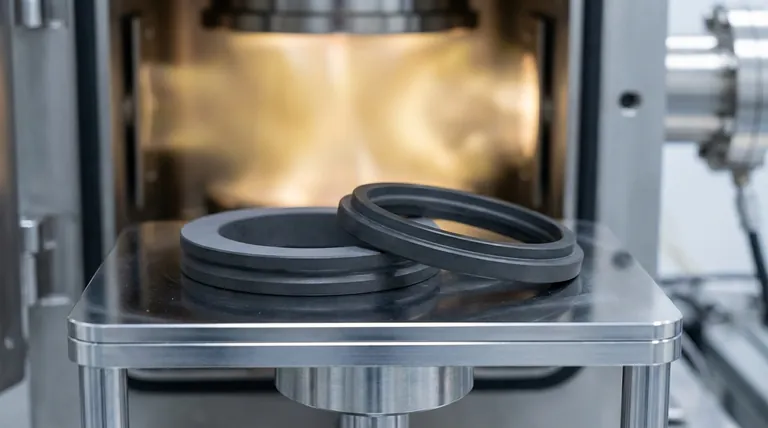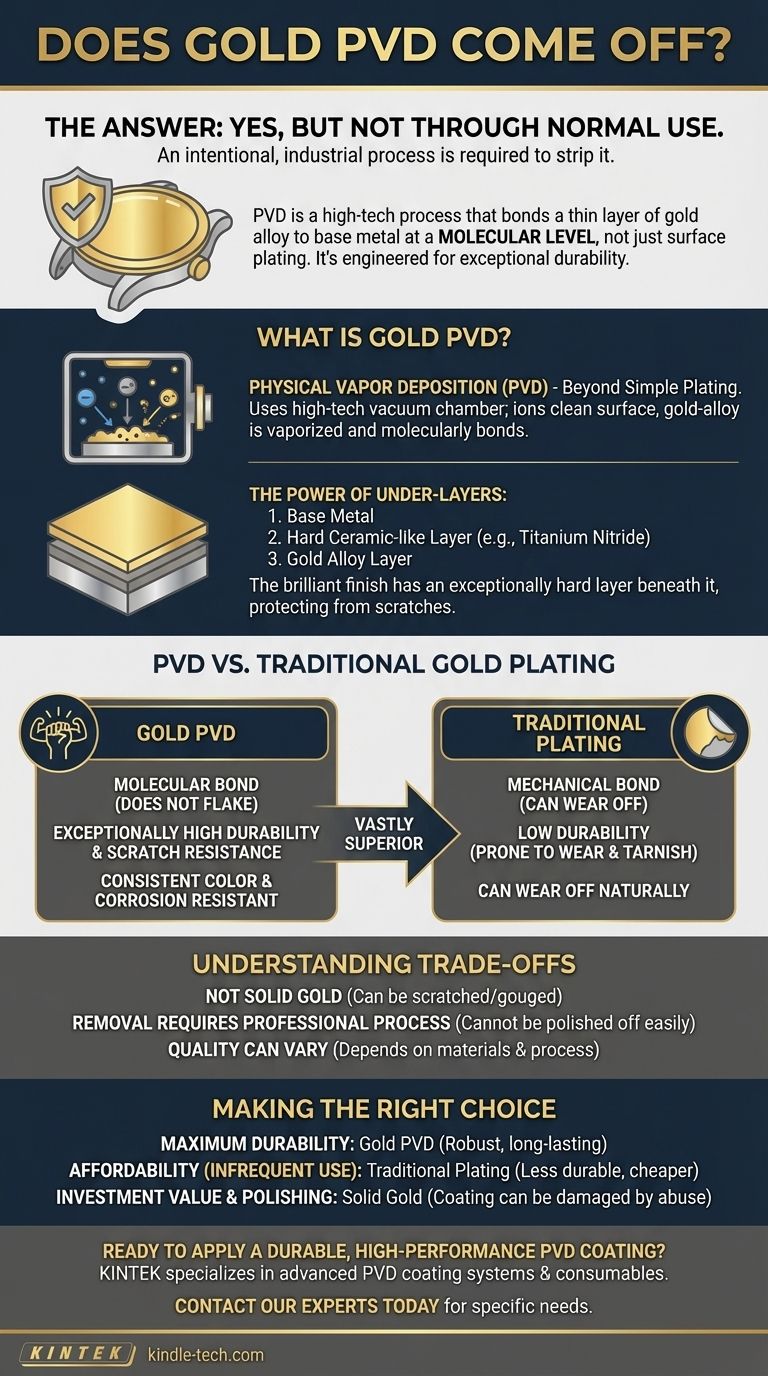Yes, a gold PVD coating can be removed, but not through normal use. The process that removes it is an intentional, industrial one designed to strip the coating without harming the underlying material. For the everyday owner of a PVD-coated item, the finish is exceptionally durable and will not flake, chip, or wear off easily.
The critical distinction is that gold PVD is not a simple coating; it's a high-tech process that bonds a thin layer of a gold alloy to a base metal at a molecular level. While specialized processes can remove it, PVD is engineered to be highly resistant to coming off through daily wear, corrosion, or tarnishing.

What Exactly is Gold PVD?
To understand why PVD coatings are so resilient, it's essential to understand the process itself. It is fundamentally different from traditional gold plating.
Beyond Simple Plating
Traditional gold plating uses an electrochemical process to deposit a layer of gold onto a metal surface. This creates a surface-level, mechanical bond, similar to a layer of paint.
Physical Vapor Deposition (PVD), on the other hand, takes place in a high-tech vacuum chamber. The base material is bombarded with ions, which cleans the surface at a microscopic level. Then, a solid gold-alloy material is vaporized into a plasma and molecularly bonds with the base metal, creating a new, integrated surface.
The Power of the Under-Layers
Most high-quality PVD coatings are a multi-layer system. A hard, ceramic-like material, often Titanium Nitride, is applied first to create an incredibly tough and scratch-resistant foundation.
The gold alloy layer is then bonded on top of this durable base. This means the brilliant finish you see has an exceptionally hard layer beneath it, protecting it from scratches and impacts.
A Molecular, Not Mechanical, Bond
Because the coating is bonded at a molecular level, it does not flake or peel away like a traditional plate. The finish becomes an integral part of the item's surface, which explains its remarkable durability.
How PVD Compares to Traditional Gold Plating
When people worry about a gold finish "coming off," they are usually thinking of their experience with traditional, lower-cost gold plating.
Durability and Scratch Resistance
PVD is vastly superior. Even though the PVD gold layer is often thinner than a thick plate, its bond strength and the hardness of the underlying titanium-based layers make it far more resistant to abrasion and scratches from daily use.
Color Consistency and Longevity
The PVD process allows for precise color control and creates a dense, non-porous finish. This makes it highly resistant to the sweat, saltwater, and chlorine that can cause traditional plating to tarnish or corrode over time.
Understanding the Trade-offs
Despite its advantages, PVD is a coating, not a solid material. Objectivity requires acknowledging its limitations.
It Is Not Solid Gold
PVD provides the appearance and surface hardness benefits, but it is not solid gold. An extremely deep scratch or gouge that penetrates the entire PVD layer can expose the base metal (often stainless steel) underneath.
Removal Requires a Professional Process
While its durability is a benefit, it also means the coating cannot be polished off or easily removed if you want to change it. As the reference material indicates, it requires a specialized "de-coating" process to strip the layers away professionally.
Quality Can Vary
The term "PVD" refers to a process, and the quality of the final product can vary. The durability depends on the quality of the base metal, the specific materials used for the layers, and the precision of the application process.
Making the Right Choice for Your Goal
Ultimately, the decision depends on what you value most in a product's finish.
- If your primary focus is maximum durability for daily wear: Gold PVD is one of the most robust and long-lasting gold-colored finishes available, far outperforming traditional plating.
- If your primary focus is affordability for an item with infrequent use: Traditional gold plating may be a more cost-effective, though significantly less durable, option.
- If your primary focus is investment value and the ability to polish out scratches: Nothing replaces solid gold, as any coated product can be damaged by extreme abuse.
Choosing a gold PVD finish is choosing a high-performance surface engineered for longevity and resilience.
Summary Table:
| Aspect | Gold PVD | Traditional Gold Plating |
|---|---|---|
| Bond Type | Molecular Bond | Mechanical Bond |
| Durability | Exceptionally High (Scratch/Corrosion Resistant) | Low (Prone to Wear & Tarnish) |
| Process | High-Tech Vacuum Deposition | Electrochemical Plating |
| Removal | Specialized Industrial Process Only | Can Wear Off Naturally |
Ready to apply a durable, high-performance PVD coating to your products?
KINTEK specializes in advanced PVD coating systems and consumables for laboratories and manufacturers. Our equipment ensures a precise, molecular bond for finishes that resist wear, corrosion, and tarnishing, enhancing the longevity and value of your products.
Contact our experts today to discuss how our PVD solutions can meet your specific application needs.
Visual Guide

Related Products
- Custom CVD Diamond Coating for Lab Applications
- RF PECVD System Radio Frequency Plasma-Enhanced Chemical Vapor Deposition RF PECVD
- Electron Beam Evaporation Coating Oxygen-Free Copper Crucible and Evaporation Boat
- Vacuum Hot Press Furnace Machine for Lamination and Heating
- Molybdenum Tungsten Tantalum Special Shape Evaporation Boat
People Also Ask
- How long does diamond coating last? Maximize Lifespan with the Right Coating for Your Application
- What are diamond coated films? Enhance Materials with Super-Hard, Transparent Layers
- What is CVD diamond coating? Grow a Super-Hard, High-Performance Diamond Layer
- What are the three types of coating? A Guide to Architectural, Industrial, and Special Purpose
- Is diamond coating permanent? The Truth About Its Long-Lasting Durability



















